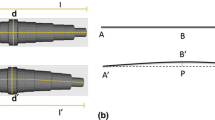Abstract
This paper investigates the internal shape correctness of alternator stators occurring in high and low temperature storage tests. This kind of failure can affect the adequate operation of alternators since vibrations can occur during rotation of the other part of the alternator, the rotor. This error can reduce the efficiency of the alternator. The aim of this study is to examine the influence of different testing parameters, such as the temperature and the running time of the test, and whether or not the stator is equipped with a damping element. For the experiments we used the full factorial experimental design method. The measurement of the cylindricity of the specimens was done with a circular and position error measuring machine. From the measured data, special improvement ratios can be calculated in order to define the appropriate range of testing parameters that resulting greater deformity. A further aim is to compare the different cylindricity parameters and the features of theirs measured values.
Similar content being viewed by others
Abbreviations
- T:
-
temperature, °C
- t:
-
time, h
- ρCYL :
-
improvement ratio of cylindricity, %
- CYLtested :
-
cylindricity deviation remaining after rapid temperature change test, µm
- CYLset :
-
cylindricity deviation remaining after setting the stator with brackets, µm
- CYLp:
-
peak-to-reference cylindricity deviation, µm
- CYLv:
-
reference-to-valley cylindricity deviation, µm
- CYLt:
-
peak-to-valley cylindricity deviation, µm
- CYLtt:
-
cylinder taper, µm
- x1, x2, x3 :
-
transformed parameters
References
Alfarawi, S., Webb-Martin, M., Mahmoud, S. and Al-Dadah, R. K. (2014). Thermal analysis of stirling engine to power automotive alternator using heat from exhaust gases. Energy Procedia, 61, 2395–2398.
Ani, S. O., Polinder, H. and Ferreira, J. A. (2014). Small wind power generation using automotive alternator. Renewable Energy, 66, 185–195.
Ayaz, M. and Mese, M. (2016). A permanent magnet alternator with increased power capability for hybrid electric vehicle applications. Electric Power Systems Research, 133, 292–303.
Dawson, D. J. W. (1992). Cylindricity and its measurement. Int. J. Machine Tools and Manufacture 32, 1–2, 247–253.
de Oliveira, M., Lima, V., Yamashita, S., Alves, P. and Portella, A. (2018). Experimental planning factorial: a brief review. IJAERS 5, 166–177.
Fridrik, L. (1987). Chosen chapters from the topics of experimental design of production engineering. Müszaki Könyvkiadó. Budapest.
Jenei, I. and Ladányi, G. (2013) Lubrication Management, book of TÁMOP-4.1.2 A1–A2, Budapest.
Lee, W., Park, H. Sunwoo, M., Kim, D. and Kim, B. (2001). Vehicle electric power simulator for optimizing the electric charging system. Int. J. Automotive Technology, 2, 157–164.
Montgomery, D. C. (2009) Design and Analysis of Experiments. 7th edn. International Student Version. Arizona State University. Tempe, AZ, USA.
Prashad, H. (1996). Diagnosis of failure of rolling-element bearings of alternators. Wear, 198, 46–51.
Starters E-Components and Generators Automotive alternator testcatalog (2018). 0 121 Y00 203 (confidential document).
Taguchi, G. (1984). System of experiment design, 1. Experimental design. UNIPUB, Kraus International Publications. New York.
Tan-Kim, A., Hagen, N., Lanfranchi, V., Clénet, S., Coorevits, T., Mipo, J.-C., Legranger, J. and Palleschi, F. (2017). Influence of the manufacturing process of a claw-pole alternator on its stator shape and acoustic noise. IEEE Trans. Industry Applications, 1.
Vítek, O. and Hájek, V. (2008). Design and analysis of an automotive alternator. Studia i Materialy, 28, 222–226.
Acknowledgement
This research was supported by the European Union and the Hungarian State, co-financed by the European Regional Development Fund in the framework of the GINOP-2.3.4-15-2016-00004 project, aimed to promote the cooperation between the higher education and the industry.
Author information
Authors and Affiliations
Corresponding author
Additional information
Publisher’s Note
Springer Nature remains neutral with regard to jurisdictional claims in published maps and institutional affiliations.
Rights and permissions
About this article
Cite this article
Varga, G., Ferencsik, V. Analysis of Cylindricity Error of High and Low Temperature Storage Tested Alternator Stators. Int.J Automot. Technol. 21, 1519–1526 (2020). https://doi.org/10.1007/s12239-020-0143-3
Received:
Revised:
Accepted:
Published:
Issue Date:
DOI: https://doi.org/10.1007/s12239-020-0143-3




